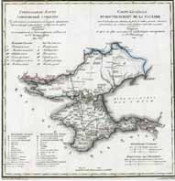
Catherine II Manifesto on accession of Crimea peninsula, Taman Island and Kuban region to the Russian empire adopted
On April 8 (19), 1783 the Empress Catherine the Great signed the Manifesto on annexation to the Russian state of Crimea peninsula and creation of Taurida region governed by prince G. A. Potyomkin who was conferred the title of Taurida for his service. The Manifesto was a logical result of the century long struggle of Russia in order to return its primordial lands and secure access to the Black Sea.
After the victories of Field Marshal General, count P. A. Rumyantsev-Zadunaisky in the second Russo-Turkish war of 1768-1774, Russia and Turkey concluded the Treaty of Kucuk Kaynarca. Under the Treaty Russia received the territory between Bug and Dnepr as well as Kerch, Enikale and Kinburn fortresses. Russia managed to obtain access to the Black Sea and confirm its rights for the territory of Kabarda, Azov and the nearby lands conquered by Peter I. The Crimea Khanate separated itself from the Ottoman Empire and declared its independence. However Turkey having acknowledged its independence was preparing for a new struggle for these territories.
The Empress charged G. A. Potyomkin with the task of providing the security of the Russian southern borders and developing the newly acquired lands. In the end of 1782 Potyomkin, considering the advantages of Crimea annexation to Russia, wrote to Catherine II: ‘The position of Crimea interferes into our borders… You must raise the glory of Russia… Crimea acquisition cannot strengthen You or enrich but will give You peace and calm’. Soon after that Catherine II issued the Manifesto on Crimea annexation. The document promised to the Crimea citizens to ‘treat them as well as our innatesubjects, defend and protect their personality, property, cathedrals and inborn faith…’.
After the Russian administration settlement in Crimea in 1783 the slave trade was abolished and the state government of the European type started to develop. The government moved here the state peasants from the central and Ukrainian lands. Gradually large landed properties concentrated in the North-Western Crimea. G. A. Potyomkin sent for the English and French specialists for arrangement of gardens and parks. He himself wrote a special instruction for Agriculture and Housekeeping Office in Crimea. Basing on the ‘Decree on provinces’ of 1775 G. A. Potyomkin created a specific system of management with involvement of local multiethnic population which contributed to the implementing the government policy on the settlement and economic development of Crimea peninsula.
Crimea annexation to Russia had a great progressive importance: economy, culture and trade started to develop promptly, the great massif of rich Crimea territories. During a short period of time in the territories near the Black Sea appeared new ports and cities. The Russian Navy asserted itself at the Black Sea.
Lit.: Андреев А. Р. История Крыма. М., 2002; Водарский Я.Е., др. Население Крыма в конце XVIII - конце XX вв. (Численность, размещение, этнический состав). М., 2003; Екатерина II и Г. А. Потёмкин. Личная переписка (1769-1791). М., 1997; Лопатин В. С. Суворов и Потёмкин. Присоединение Крымского ханства к России. 1782-1783 гг. [Электронный ресурс] // Адъютант. 2003. URL: http://history.scps.ru/suvorov/lopatin06.htm.
Based on the Presidential Library’s materials:
Броневский В. Б. Обозрение Южного берега Тавриды. В 1815 году. Тула, 1822;
Виды Крыма = Vues de Crimée : [альбом фотографий]. Стокгольм, [19--];
История Российского государства: территории и границы: мультимедийный проект. СПб., 2010;
Кравен Э. Путешествие в Крым и Константинополь в 1786 году милади Кравен. М., 1795;
Лашков С. С. Шагин-Гирей, последний крымский хан: Исторический очерк. Киев, 1886;
Маршрут высочайшего путешествия государыни императрицы в Крым 1861 г. СПб., 1861;
Муравьёв-Апостол И. М. Путешествие по Тавриде в 1820 году. СПб., 1823;
По поводу столетнего юбилея присоединения Крыма: Ист. очерк. Симферополь, 1883;
Полное собрание законов Российской Империи. Т. 21 (1781-1783). № 15708. СПб., 1830;

